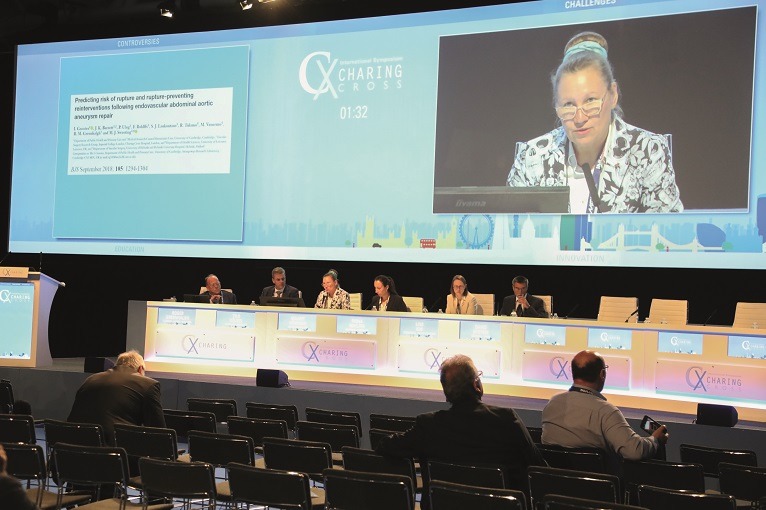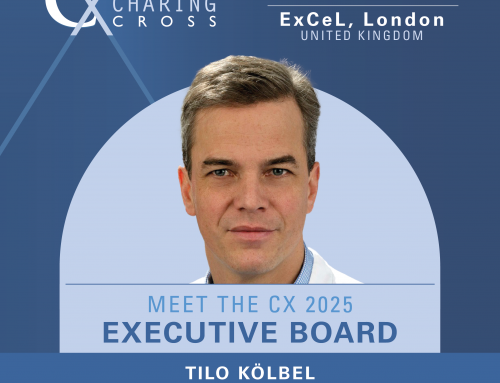
The durability of endovascular aneurysm repair (EVAR) is in the limelight as the UK vascular community awaits the final aortic aneurysm guidelines from the National Institute for Health and Care Excellence (NICE), set to go against widespread endovascular practice in recommending open repair over EVAR. In May 2018, the clinical guidelines committee chaired by Andrew Bradbury (Birmingham, UK) released a draft guidelines document which suggested with its recommendations that EVAR procedures do not justify national funding from the UK National Health Service (NHS)—instead encouraging a return to open surgical aneurysm repair.
Explaining how the clinical guidelines committee had arrived at these conclusions, Bradbury outlined the strict decision-making pathways laid out by NICE for its advisory committees. These, he stated, ensure that long-term, randomised controlled trial data—and UK-based data in particular—are favoured over other evidence, with the reasoning that this implies the data are more directly applicable to an NHS setting. It was this principle that made the EVAR 1 and EVAR 2 trials a major contributing resource for the clinical guidelines committee, with its significant 15 years of long-term follow-up of abdominal aortic aneurysm patients.This was the topic of discussion at a CX Highlight Session yesterday, in which Tara Mastracci (London, UK) argued for EVAR as “standard of care”: a term which in North America implies practice that is widely accepted, publicly funded and/or reimbursable. Mastracci’s argument stood in contrast with the NICE aortic guidelines, as did a range of speakers in the session who set out key arguments against the NICE committee’s proposed recommendations.
EVAR 1 compared endovascular repair to open repair of abdominal aneurysms in patients who were fit for open surgery. At the time of enrolment for this trial, in the 1990s, EVAR provided a novel treatment option for these patients, and although the technology was in its early stages, the vascular community was increasingly appreciating the potential of a minimally invasive treatment for patients who were unfit for open surgery. At 30 days, EVAR 1 showed that endovascular repair resulted in an early superiority over open repair. This superiority was maintained for over six years, as observed in long-term follow-up, but results thereafter started to suggest the trend could be going against EVAR. At 10-year follow-up and beyond, this suspicion was confirmed, reporting late catch-up in mortality for the EVAR arm. Outlining the issues of this early endovascular trial at the CX Highlight Session, Fiona Rohlffs (Hamburg, Germany) described how EVAR fell behind, due to aneurysm-related and all-cause mortality—mainly due to secondary sac rupture, from which two of every three patients would die. “We see that of course initially there was a benefit for EVAR, but EVAR compared inferiority to open surgery during follow-up—especially in the period after eight years. The cause of this was mortality from secondary rupture in this group,” said Rohlffs.
A panel at the CX Highlight Session, which included Roger Greenhalgh, Rohlffs, Maarit Venermo (Helsinki, Finland), Lois Kim (Cambridge, UK) and David Epstein (Granada, Spain), who together presented new analysis based on the EVAR trials and a current series experience by Venermo in Helsinki, then highlighted a key issue with the long-term EVAR data. It was identified that post-EVAR surveillance in terms of follow-up protocol had fallen short, described by Greenhalgh and by Venermo as “suboptimal”. “In EVAR 1, patients failed to turn up for their follow-up appointments”, explained Greenhalgh, “and this is the main reason why reintervention was not performed.” The failure of follow-up ultimately led to the “inevitable outcome”, that EVAR was not cost-effective based on the protocol and practices of 1999–2004 data.
Presenting more recent EVAR practice data from 2010–2011, Greenhalgh noted, that a predisposition of certain patients to rupture was identified in a “cluster”. This cluster held a range of issues, including type I endoleak and type II endoleak with sac expansion, migration and kinking of the stent graft. Importantly, Rohlffs pointed to Wyss et al, who showed in 2010 that most patients had sac expansion before rupture of the aneurysm sac. Nevertheless, though centres were reportedly warned of the risks following EVAR, many patients failed to adhere to surveillance protocols and were lost to follow-up.
Indeed, Rohlffs showed that the initial 90% follow-up retention in the first six months of EVAR 1 had dropped to only 10% of all survivors at nine years. Underlining that this problem is not restricted merely to the UK, Venermo presented similar numbers from her data, showing a 90% follow-up in the first six months, which dropped to 40% of survivors in its ninth year. “You can see this situation in the Finnish series, as only 40% at nine years came back for annual CT scan”, Venermo said, “and this is for many reasons: it is because of a lacking engagement of the patients with the surveillance, but also sometimes it is a certain decision of the patient.”
Therefore, in collaboration with a statistical team led by Michael Sweeting (Cambridge, UK), a discrete event simulation predictive model was produced by Kim, in order to model alternative outcomes of follow-up scenarios. The scenarios supposed a range of follow-up strategies, including a scenario assuming “perfect follow-up” in the EVAR trials, and application of various guidelines for follow-up, such as those of the European Society for Vascular Surgery (ESVS). A fifth option was to curtail follow-up at five years, and simulate the recommended protocol, as recently proposed by NICE. A final scenario assumed a novel strategy, based on the 2018 study of Grootes et al in the British Journal of Surgery, which examined the risk of rupture and rupture-preventing reinterventions following endovascular abdominal aortic aneurysm repair. A co-author of this study, Venermo commented: “We tried to figure out if it was possible to predict rupture-preventing interventions and secondary sac ruptures on the basis of sac diameter and changes in diameter.”
Venermo showed a series of trajectories, which outlined sac diameter over time of follow-up, grouped by type of event. These trajectories of annual sac diameter change were first described by Sweeting. For patients in whom there was no rupture nor any rupture-preventing reinterventions, Venermo showed that, for the EVAR trials as well as in the Helsinki cohort, “we can see decreasing trend in sac diameter.” For patients who underwent rupture-preventing reintervention with no subsequent rupture during a 10-year follow-up, he said: “Actually, the sac diameter decreased or increased slightly but, in the end, it remained pretty much the same.” Finally, for patients who experienced a secondary sac rupture, the trajectories showed a “clearly increasing trend in maximum sac diameter.”
Venermo summarised in accordance with her colleagues, saying, “Indeed, current EVAR follow-up protocols are suboptimal. It is too heavy, it is expensive and patients do not follow or engage with it. I think we can all agree that we need lifelong surveillance after EVAR—but it has to be patient-friendly, simple and safe.” Greenhalgh further highlighted that sac expansion, “with great accuracy, was a prediction of imminent secondary sac rupture occurrence within two years.”
The group then took the next step from these findings, and established whether recent advances in technology may have presented new potentials for alternative and more flexible, yet reliable, follow-up and surveillance protocols. They worked on the assumption that sac diameter would be able to be monitored at home, by the patient, in the community—thereby dispensing of the need for a visit to the hospital to undergo an annual CT scan. It was argued by the panel that this would present a patient-friendly option, and Greenhalgh subsequently presented the audience with a hand-held device that could perform this task: a mobile, light-weight device which could be used by the patients themselves—in combination with a smartphone—to perform a Doppler ultrasound scan of the aortic diameter. This, Greenhalgh said, is a technology that will come to “revolutionise” aneurysm care.
The use of a hand-held monitor, to increase follow-up retention and perform rupture-preventing reinterventions in patients whose aneurysm sac had been identified to be at risk of rupture, was then incorporated as a factor in the novel proposed surveillance strategy. Health economist Epstein concluded from the panel that the novel strategy, as analysed by Kim in a discrete event simulation, presented not the most clinically effective, but rather the most clinically effective option at a cost that is affordable within the context of the NHS. As such, the findings of this multi-disciplinary group respond directly to the claim of the NICE aortic guidelines that reverting back to open repair and restricting EVAR funding presents lower cost per quality-adjusted year. “Now,” Greenhalgh maintained, “it is necessary to show that this simulated event can be created in the real world—using a simple and mobile device in combination with a smart phone.”
Polling at the close of the session revealed that the CX audience agreed, with 82% responding they believe that “By tracking sac growth after EVAR, EVAR will be more clinically effective and at lower cost than occurred in the EVAR trials”. Throughout this CX Highlight Session, signals were sent to the vascular community not to withhold EVAR when “around the corner,” Greenhalgh said, “is a cost-effective way of ensuring EVAR can be performed with long-term safety, with more patient-tailored methods.”







